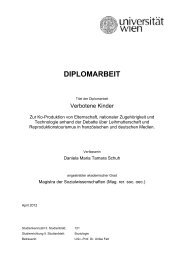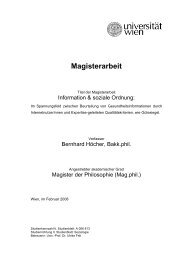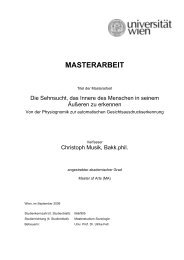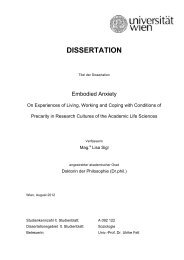MASTERARBEIT - Institut für Wissenschaftsforschung - Universität ...
MASTERARBEIT - Institut für Wissenschaftsforschung - Universität ...
MASTERARBEIT - Institut für Wissenschaftsforschung - Universität ...
You also want an ePaper? Increase the reach of your titles
YUMPU automatically turns print PDFs into web optimized ePapers that Google loves.
ABSTRACT<br />
The thesis at hand analyzes an aspect of the emergence of zeppelin airships<br />
in Germany during the first decade of the 20th century. Particularly<br />
the engagement of a broad public to support the development<br />
of the zeppelin technology by financial aid is a point that is taken under<br />
scrutiny. The interest for this question emerges from the fact that<br />
hardly any return was to be expected for supporters. It thus comes to<br />
mind to ask why people would engage if no return is to be expected.<br />
Furthermore the question is interesting to study because the support<br />
for Count Zeppelin, the inventor behind the airship, emerged rather<br />
quickly after years of relative disinterest.<br />
Using the methodology of Social Construction of Technology (SCOT),<br />
the author explores how this technology eventually became very popular<br />
after having been widely ignored for years. The research focuses<br />
on the timespan around the general public’s turning from a skeptical<br />
to a very supportive attitude after the crash of a prototype in the<br />
summer of 1908.<br />
Additionally to the SCOT approach, the concept of Sociotechnical<br />
Imaginaries is introduced and combined with SCOT methodology in<br />
order to enhance the capabilities of the analysis. Sociotechnical imaginaries<br />
provide a particular understanding for the role time and futurebound<br />
expectations played in the support of the technology.<br />
The analysis concludes that a combination of technological progress<br />
in terms of the reliability and capability of the airships themselves as<br />
well as a fit with the social and political events of the time formed<br />
the basis for a very fast change in peoples’ perception of it in the<br />
summer of 1908. Furthermore, it is observed that the zeppelin development<br />
did also profit from an inner political conflict in Germany at<br />
the time. While not being an actual part of it, it was used as a means<br />
to demonstrate the people’s resistance against Wilhelminian monarchy,<br />
which led to a stronger support than there might have been for<br />
solely technological reasons.<br />
Moreover, the study contributes to the use of SCOT for the description<br />
of technological development by successfully integrating some<br />
sociotechnical imaginaries, the attempt to reach a more detailed analysis<br />
in terms of both the timely character of elements at work in the<br />
process and the emergence of those elements in the first place.<br />
iii







